Russian campaign in Syria exposes gas war reality behind “war on terror”
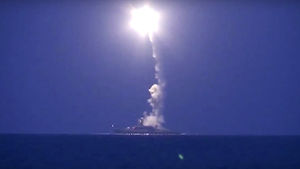
On our weekly radio show last Sunday, I commented that the response from the U.S. and its Western allies to Russia’s launch of an actual war on terrorism in Syria has been largely silence, deafening silence, a bit like Netanyahu’s ‘silence spectacle’ at the UN recently, only even more deafening. So deafening in fact, that it came full circle and I began to hear something.
At first it was just a mealy-mouthed American-accented, ‘Russia is making things worse’. But it quickly grew in strength to announce in a Queen’s English accent, “we’re bombing ISIS too you know!” And before long it had become a cacophonous copracopia of nonsense about Russia “killing innocent civilians in Syria” and, most recently, “dangerously invading the airspace” of our NATO ally Turkey.
Still, it was, and is, all ‘sound and fury’, because the bottom line is that U.S. has had its ‘war on terror’ bluff called in spectacular fashion by Russia and there is nothing, and I mean nothing, that the terror masterminds in Washington and Langley can do about it, short of declaring war on Russia.
The only more or less honest statements about Russia’s move into Syria from the West have come from the same person, U.S. Air Force Gen. Philip Breedlove, head of U.S. European Command. Speaking on Sept. 28th at a meeting in Berlin of the ‘German Marshall Fund’ – a US think tank that commemorates the Marshall Plan, an initiative through which the USA gained economic control over most of Western Europe after WW2 – Breedlove said that Russia had installed “very sophisticated air defense capabilities/anti-access area denial” that were not aimed at the Islamic State but “about something else“. Of course, “something else” here means “NATO bombs”.
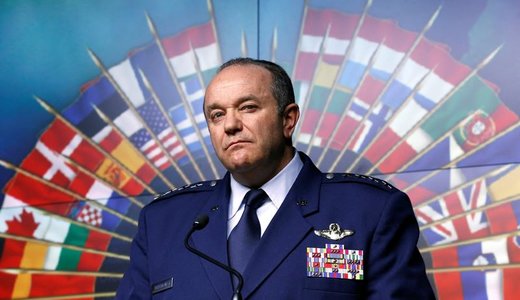
At the same meeting, Breedlove also said that US aircraft had begun arriving at Diyarbakir Air Base in southeast Turkey so as to “better recover our coalition partners should they need assistance in Syria or Iraq.” This was an informed and well-advised move, because about 36 hours later a Russian general walked into the US embassy in Baghdad and told a consulate staffer “bombing begins in an hour.” We’ll never know if any CIA/US military operatives frantically requested an ‘evac’ from the vicinity of ISIL or FSA training camps in Syria just before Russian missiles turned them into holes in the ground, but the thought that they may have is very inspiring.
Most people reading this have no doubt already internalized the objective truth about the US-led war on terror; that it is nothing more than a cynical cover for US imperial expansion, specifically aimed at ‘containing’ Russia as the only real threat to US global hegemony. For the last 70 years or so, that hegemony has been secured largely through US control over Middle Eastern oil by way of repeated US meddling in the affairs of Middle Eastern nations, up to and including carrying out coup d’etats and other dirty tricks to destabilize the region. At the same time, Washington expended vast amounts of money and military power to control other nations around the world and enforce a ‘pax Americana’ that ensured the USA stayed on top.
Hegemony by design
The USA is today the world’s largest producer of oil, but it is also the largest consumer of oil. Around the time of WW2 consumption of oil in the US began to outstrip production. That trend has continued ever since, meaning that the USA consumes all of the oil it produces, and consumes roughly the same amount again. Securing and maintaining an abundant source of hydrocarbons for Empire has, therefore, always been the top priority for the US State Dept.
During the First World War when the ‘Allies’ fought against the Central powers of Europe, the British entered into a treaty that made the lands of the House of Saud in modern-day Saudi Arabia a British protectorate. After the war and the fall of the Ottoman Empire, Western powers, in particular the UK and France, drew the map of the modern Middle East and sought to control the new nation-states and their resources. The state of Saudi Arabia was gerrymandered and placed under the control of Ibn Saud, the tribal leader of the ‘House of Saud’.
As had been expected, petroleum was discovered in Saudi Arabia in 1938 by American geologists working for Standard Oil of New York in partnership with Saudi officials. Saud, who by then had made himself ‘king’, granted substantial authority over the oil fields to the US-controlled Aramco (Arabian American Oil Company), much to the dismay of the British who had financed the House of Saud’s rise to power in hopes of open access to any oil reserves that were to be surveyed.
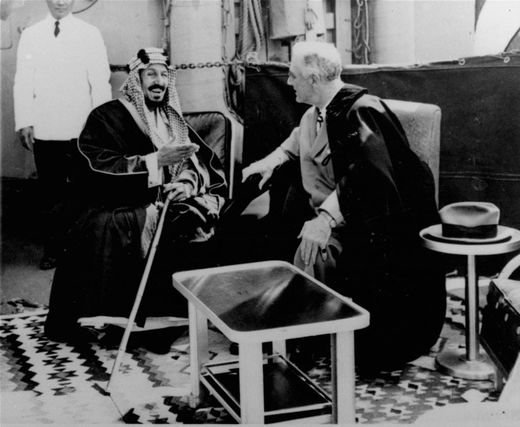
After World War 2, most of Europe, Russia and the major Pacific countries were in varying states of economic ruin and racked with war debt. The US, on the other hand, having played a relatively small part in the war, and having extended massive loans (in cash and armaments) to many of the warring parties, was in a economically commanding position.1 As a ‘safe haven’, it had also acquired about 80% of the world’s gold from its allies during the war, and from pilfering the supplies of conquered enemies, most notably Japan.2 Because of its economic strength, 44 countries came together in 1944 at the Bretton Woods conference and accepted the US plan to make the dollar the world’s reserve currency, backed by gold. That is to say, every dollar was directly convertible to gold at a fixed rate. This massively increased the global demand for dollars and inspired confidence in the US economy, giving the USA a ‘free ride’ economically-speaking. At the same time however, the US ‘welfare and warfare state’ was limited by the amount of dollars it could print by the amount of physical gold it held.
By the 1960s, as a result of reckless spending and warmongering around the world, the US had racked up a dollar debt pile that outstripped the amount of physical gold it had to back it. Confidence in both the dollar and the US economy decreased and many nations began to exchange their dollar holdings for physical gold. The Washington elite realised that they could not continue to live so ‘high on the hog’ and maintain the ‘dollars-for-gold’ scheme. But rather than tighten their belts and engage in fiscally responsible behavior, President Nixon and Kissinger came up with a plan to back the dollar not with gold, but ‘black gold’.
Enter the petrodollar
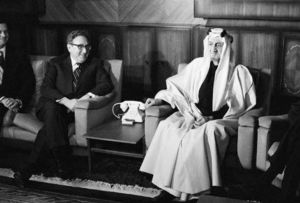
In 1973, in return for the supply of large quantities of military equipment, protection and an assurance that they would remain kings of the desert forever, the US government struck a deal with the Saudis whereby all Saudi oil had to be paid for in dollars. In return for the same assurances, all other Middle Eastern members of OPEC soon followed suit. This new oil-for-dollars scheme, also known as the ‘petrodollar‘, was even better than the dollars-for-gold scheme because not only did it reinforce perpetual international demand for dollars, but the US itself could buy all of its oil from the Saudis and others for the cost of printing some paper. In addition, Gulf states agreed to invest their excess profits from oil sales in the US economy.
Normally, the value of a nation’s economy and currency is determined by its GDP, or the value of the stuff it produces and is able to sell. Since the advent of the petrodollar however, the value of the US economy has been based largely on the amount of money it can print. That’s a pretty sweet deal by any standards.
Dr. Bulent Gukay of Keele University puts it this way:
“This system of the U.S. dollar acting as global reserve currency in oil trade keeps the demand for the dollar ‘artificially’ high. This enables the U.S. to carry out printing dollars at a price of next to nothing to fund increased military spending and consumer spending on imports. There is no theoretical limit to the amount of dollars that can be printed. As long as the U.S. has no serious challengers, and the other states have confidence in the U.S. dollar, the system functions.”
If the petrodollar was ever replaced by another currency by mass selling-off of dollars, value of the dollar would plummet as it would no longer be so useful to just about every country on the planet for buying oil. Untold billions in USDs would then flow back into the USA, leading to hyperinflation, interest rate hikes, massive job losses and generalized economic and social chaos. It would, in essence, spell the end of the USA as we know it. If and when the US economy recovered, there would be no more Federal Reserve printing of dollars to solve economic problems, safe in the knowledge that everyone would snap them up in exchange for real goods. The amount of money in the system would have to be slashed, leading to a drastic reduction in the size of the US economy and the USA finally taking its rightful place waaaay down the list of the world’s most powerful nations.
It should, therefore, be fairly obvious why Middle Eastern oil and the corrupt Middle Eastern regimes that control it are so existentially important to the USA as ‘number 1’. But what could possibly cause the replacement of the petrodollar?
Subverting the natural order
Look at a map of the world and notice that the USA is separated from the landmass of Eurasia by two large oceans. Eurasia has over 60% of the world’s population and about the same percentage of its resources. Left to its own devices, the bulk of world trade would occur between nations on the Eurasian landmass, and that landmass would be the economic ‘center’ of the world. That is, however, not how the world works today. Instead, the USA is both the world’s ‘biggest economy’ and its ‘only superpower’.
Two world wars and many other ‘low level’ conflicts were waged by the USA to create this imbalanced state of affairs where Eurasia is divided against itself. Today Western Europe is aligned with the USA against Russia (and to some extent China), and the Middle East is largely controlled by the US and the UK, or ‘anglo-America’ as I like to call those two perfectly-suited bedfellows. Most of the continent of Africa has been exploited for its resources and kept impoverished by these same two countries (along with the French), and South America has, until relatively recently, been subjected to the same treatment.
In this article, I explained how, for most of modern history, and certainly the entire 20th century, the major objective of anglo-America has been to thwart Russian expansion. While the efforts to do this were couched in ideological terms to encourage public support, the real motivation was a very realistic understanding among American and British power-brokers that if Russia were to develop to the extent that its resources and geographical position would naturally allow, then Russia, not anglo-America, would rule the world in league with the rest of Eurasia and probably Africa.
9/11 and the Scramble for the Middle East
When the ‘cold war’ ended, anglo-America was left without a rationale to continue in its self-appointed role as upholder of the global ‘peace’ and bestower of ‘freedom and democracy’ on all. Intelligent people cannot fail to find it rather coincidental that within 3 years of the fall of the Berlin wall and the disappearance of the ‘Communist threat’, ‘Middle Eastern Muslim terrorism’ was already ‘a serious problem for America’.
The first ‘Muslim terror attack’ in the USA occurred at the WTC in 1993. Five years later, Osama bin Laden was allegedly bombing US embassies in Africa and Washington policy-makers were writing papers about the need to establish “forward-based forces in the Middle East” and the need for a “catastrophic and catalyzing event – like a new Pearl Harbor” – to justify creating military fortresses in the region.
In November 2000, Saddam Hussein declared that Iraq would soon only accept payment for Iraqi oil in Euros. Less than 1 year later, the 9/11 attacks occurred, and 18 months after that, the USA invaded and occupied Iraq. By June 5th 2003, Iraq’s oil was once again for sale in US dollars. A coincidence I’m sure.
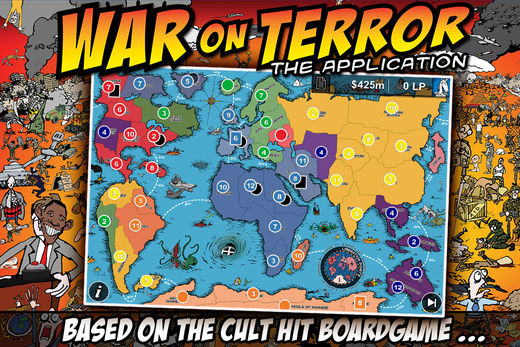
In 2002, the Los Angeles Times reported that in April 2000, more than one year prior to the 9/11 attacks, the U.S. began constructing Al Adid, a billion-dollar military base in Qatar with a 15,000-foot runway. Washington’s stated justification for the new base was “preparedness for renewed action against Iraq.”
A Pentagon document dated March 5th, 2001, entitled Foreign Suitors for Iraqi Oil Field Contracts details how Iraq’s oil fields would be carved up and outsourced to Western oil companies. This was two years before the invasion. A March 2003 article in the Baltimore Sun quoted former Assistant Secretary of State for the Near East, Edward Walker, saying that an invasion of Iraq was at the top of the Bush administration’s agenda only 10 days after his inauguration, a full eight months before 9/11. But all those are just weird coincidences.
The 9/11 attacks were not, of course, designed solely to justify the occupation of Iraq. Iraq was merely the first on America’s ‘to be dealt with’ list. Afghanistan was also invaded and occupied (it still is!). If you look at a map (maps are useful!) of the world and look at the Middle East and Afghanistan and consider the geopolitics of oil and gas, and realize that Russia and China are the US Empire’s main competitors, and if you throw in ‘4th generation warfare’ in the form of armies of irregular jihadi mercenaries controlled by the Saudis that can be sent anywhere and everywhere, you come close to understanding the reason for most of US foreign policy over the past 15 years.
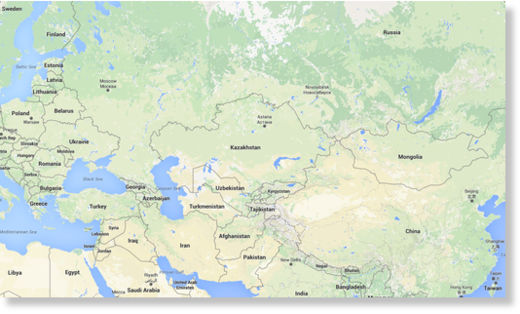
Incidentally, other countries that have moved, or have attempted to move, away from using the petrodollar include Russia, Iran, Syria, Libya, Venezuela, and North Korea.
The US presence in the Middle East since 9/11, involving the invasion and occupation of Iraq and Afghanistan, the bombing of Pakistan, the overthrow of Gaddafi and the manufactured ‘civil war’ in Syria, have all had one goal, and it’s the same goal as always: thwarting Russian (and to a lesser extent Chinese and Iranian) economic expansion beyond their borders and protecting the hegemonic status of the petrodollar. In a nutshell, if Russia, China and Iran are permitted to engage in free trade with each other and the other countries to their south and west, the days of the petrodollar, and therefore anglo-America, are numbered.
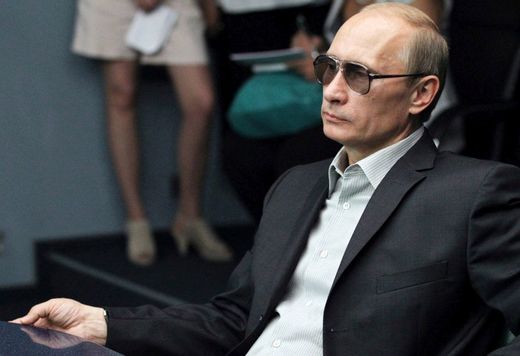
Containing Russia through Ukraine
Closely linked to anglo-America’s desperate attempts to protect the petrodollar is its hysterical drive to not only block closer economic ties between Russia and Europe, but also to roll back those that already exist. The US in particular sees European dependency on Russian gas (and any major oil producer not ‘owned’ or readily influenced by the US) as a major threat to continued European commitment to anglo-American ‘values’ of keeping America on top.
Early last year, as the manufactured ‘civil war’ in Syria raged, the US State Dept. organised a coup in Ukraine that ousted the pro-Russian government and installed a quisling outfit that has set a new standard in fawning subservience to the West. Ukraine has historically been a major transit hub for Russian gas to Europe. The US hoped that it could somehow staunch the flow, forcing Europe to look elsewhere for its gas.
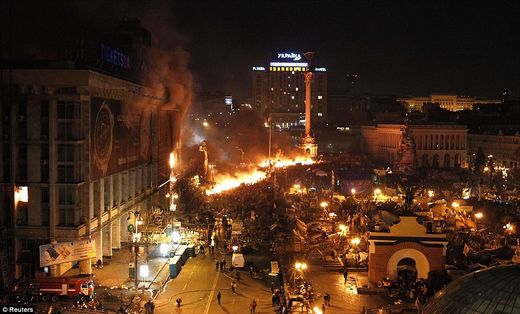
In initiating the coup, the US also (or primarily) hoped to evict Russia’s Black Sea fleet from Crimea, which would have dealt a blow to Russia’s planned military involvement in Syria. Russia was, obviously, well aware of the real intent of the Ukraine coup and took action by welcoming Crimea back into the Russian Federation. Russia’s Crimea gambit was then used by the Western media to provoke hysterical reactions from EU governments about Russia’s intent to invade all of Europe and thereby convince Europeans that they needed to ‘diversify’ away from Russian gas. But 18 months later, Russian gas is still flowing through Ukraine to the EU. It’s one thing to expect European governments to disseminate the USA’s ‘Russia is evil’ propaganda; it’s quite another to expect them to let their citizens go cold and their factories shut down in the interest of US foreign policy that amounts to ‘if I can’t have you, no one can’.
Syria at the crossroads
Syria is a long-time ally of both Iran and Russia and, along with Hizb’allah and the Palestinians, the last remaining advocate for a secular, progressive, Arab nationalist-governed Middle East. As such, the Syrian government opposes everything that the traitorous Wahhabist head-chopping ideologues in the Gulf Monarchies stand for, in particular their decades-long facilitation of an anglo-American policy of Middle Eastern thievery and warmongering, which has been significantly advanced by the same Wahhabist head-chopping ideology promoted by both the head-choppers and Washington elites since the 1970s in support of their petrodollar scheme. Syria, home to millions of Palestinian refugees since 1948, has never been too keen on Israel either.
As already noted, anglo-America is desperate to source another supply of gas for Europe. Little can be done in the short-term about the North Stream pipelines going directly to Germany, and the flow through Ukraine, but a planned ‘South Stream‘ that would deliver Russian gas to Southern Europe was a bridge too far for the anglo-American Empire.
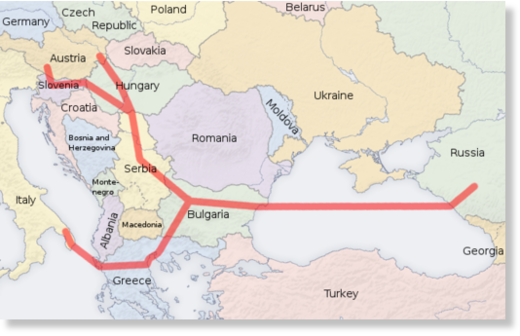
Announced in 2007, South Stream looked like a sure thing until April 2014 when Crimea rejoined Russia and everyone freaked out about the Russian boogeyman. Having provided the rationale via the coup that forced Russia to protect its Black Sea fleet, Washington urged its European lackeys to cancel the project. The EU Parliament duly did so, adopting a non-binding resolution opposing the pipeline and recommending a search for alternative sources. Luckily for the EU and its masters in Washington, an alternative source was already in the works in the form of the Qatar-Turkey pipeline that was proposed back in 2002 and would carry Qatari gas to Turkey and the EU. It would, however, have to pass through Syria. When asked for their agreement, the Assad government refused because it wanted to “protect the interests of [its] Russian ally, which is Europe’s top supplier of natural gas“.
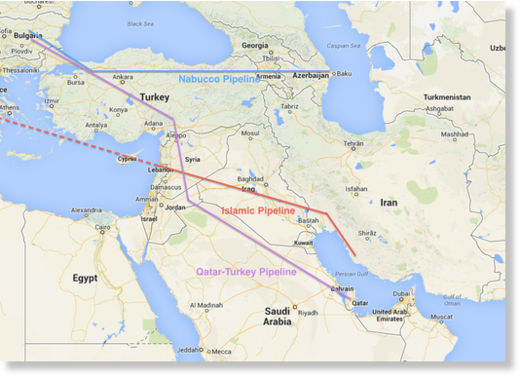
What the Syrian government meant by “protect the interests of its Russian ally” was not that it would never allow a Middle Eastern gas pipeline to cross its territory to Europe, but that it would only allow certain pipelines, controlled by certain countries, to do so. Ideally, Russia would like to prevent Middle Eastern gas from supplanting Russian gas in the EU market, but failing that, it could live with another friendly Middle Eastern (or Iranian) supplier who would invite Russia to develop the reserves.
After rejecting the Saudi offer, Syria signed up to the Iran-Iraq-Syria pipeline that would carry gas from same field in the Persian gulf shared by Iran and Qatar (but from the Iranian side), through Iran, Iraq, Syria and Lebanon and then under the Mediterranean, probably to Greece. From that point onwards, both Qatar and Turkey (along with the Saudis) were fully in the ‘Assad must go!’ camp, and began supplying jihadis and weapons to instigate and fuel the Syrian ‘civil war’. As a result of the conflict in Syria however, the Iran-Iraq-Syria pipeline has been delayed and Turkey is threatening Russia with cancellation of the proposed ‘Turkish Stream’ pipeline and an agreement where Russia would build Turkish nuclear reactors.
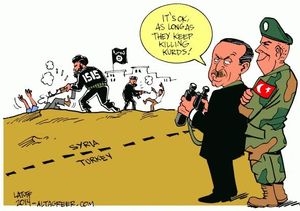
Turkey is also a major consumer of Russian gas and Turkish president Erdogan has claimed that he could look elsewhere for supplies, but then, isn’t that what he was already trying to do by supporting the removal of Assad so that the Qatar-Turkey line could be built? Russia is not so easily fooled.
You may be wondering what Afghanistan has to do with all of this, given that it is landlocked on the other side of Iran next to Pakistan. You probably won’t be surprised to learn that Afghanistan also has vast reserves of gas and oil and that, in 2010, US geologists discovered huge veins of iron, copper, cobalt, gold and critical industrial metals like lithium. But before any of that can even be extracted, Afghanistan plays a critical role in the transport of Caspian sea oil and gas to China, Pakistan and India, three very populous developing countries that need a lot of energy. Afghanistan, which shares a small border with China, signed an oil exploration contract with China National Petroleum Corporation in December 2011. But let’s get back to Syria.
In mid-2013, with the US, UK, Gulf Monarchies and Turkey all engaged in trying to remove Assad, the head of Saudi intelligence, Prince Bandar flew to Moscow for a meeting with Putin. Bandar came bearing promises and thinly-veiled threats to Russia over Syria:
“Let us examine how to put together a unified Russian-Saudi strategy on the subject of oil. The aim is to agree on the price of oil and production quantities that keep the price stable in global oil markets. We understand Russia’s great interest in the oil and gas in the Mediterranean from Israel to Cyprus. And we understand the importance of the Russian gas pipeline to Europe. We are not interested in competing with that. We can cooperate in this area,” Bandar said, purporting to speak with the full backing of the US.
Bandar further pledged to safeguard Russia’s naval base in Syria if the Assad regime is toppled, but also hinted at Chechen terrorist attacks on Russia’s Winter Olympics in Sochi if there was no accord. “I can give you a guarantee to protect the Winter Olympics next year. The Chechen groups that threaten the security of the games are controlled by us. These groups do not scare us. We use them in the face of the Syrian regime but they will have no role in Syria’s political future.” Bandar said.
These were hollow threats and promises from a screwball head-chopper with delusions of grandeur. The Saudis have no leverage over Qatar (only anglo-America does) and while Russia could have benefited from Saudi help in keeping oil prices high, Putin wasn’t about to trust this fanatical pseudo-Muslim ‘prince’. His response was rather appropriate:
“Our stance on Assad will never change. We believe that the Syrian regime is the best speaker on behalf of the Syrian people, and not those liver-eaters.”
One year later, undoubtedly on the orders of the US, the Saudis increased oil output in order to suppress global market prices, thereby decreasing Russian oil revenues. This maneuver occurred in tandem with an organised Western financial attack on the Rouble. Russia survived, and one year later began to bomb Prince Bandar’s liver-eaters in Syria.
What is most striking about the several Middle East gas distribution projects that are being touted to replace Russian gas to Europe is that all of them would be much more costly to build than Russia’s South Stream – the pipelines for which are almost completed – or the alternative ‘Turkish Stream‘ proposed by Russia late last year. Qatari gas lines would have to run 5,000km through 4 countries to get to the EU compared to the 1,000km straight shot under the Black Sea for South Stream or ‘Turkish Stream’. Then again, we shouldn’t expect much sense from the deranged and enraged anglo-American Empire or its head-chopping nutjobs in the Middle East as they desperately attempt to stop Russia at all costs.
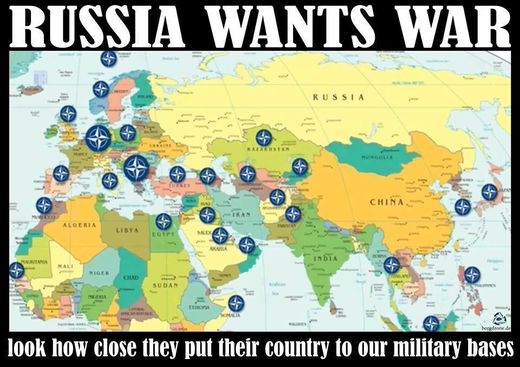 Israeli interests
Israeli interests
You may have noticed that Israel has shown an unusual passivity (by Israeli standards) in the face of what we might think is a prime opportunity to hasten the demise of its long-term enemy Syria. There are several reasons why Israel has not been fully engaged in the campaign to remove Assad and his government:
1.) The Saudis, Qataris, Turks and anglo-Americans are doing a pretty good job of it (or at least they had been until now)
2.) While Israel has money in the gas game in the form of the Leviathan field off its coast, it does not need Syria to transport it to anyone.
3.) Israel and Russia are not enemies. In 2013, Gazprom signed a 20-year deal with the Israeli firm Levant LNG Marketing Corp. to exclusively purchase liquefied natural gas from Israel’s Tamar offshore gas field.
4.) Israel already stole a chunk of Syria in 1967 – the Golan heights – and has no intention of giving it back. As a bonus, a large oil deposit was recently discovered there.
5) Israel is never happier than when its Middle Eastern neighbors are fighting each other. If Israel takes any action at this juncture, it will be to use the ‘fog of war’ to initiate a ‘final solution’ to its most pressing Palestinian problem.
What to Expect from here
I’m no remote viewer, but I think we can expect the U.S. to respond to Russia’s Middle East meddling in the only real way it can – ‘asymmetrically’. Continued defamation, slander and outright lies about what Russia is doing in Syria, Ukraine, Europe and anywhere else Russia or Putin pops up. In the same vein, expect continued pressure to be put on EU states that are potential transit points for future Russian gas pipelines, like Greece and Macedonia. The EU president has already publicly stated that ‘foreign politicians’ (guess who) deliberately provoked the ‘refugee crisis’ to “weaken Europe.” Notice the countries that have been in the firing line there: Greece, Macedonia, Hungary. ‘ISIL’, of course, could always be pulled out of the bag to carry out terror attacks and destabilize Balkan states (Albania for example). Then again, that’s partly why Russia is bombing the Saudi mercenaries as we speak.
The fact remains that Europe is the USA’s ‘ally’ only as long as it continues to toe the line on US policies, even those that are clearly damaging to EU member-states. But that’s a dangerous game for the US to play. Like the schoolyard bully who mistakes the silence of the other kids for acceptance of his behavior, Washington may wake up one morning to find that some of its closest allies have been plotting against it, even in league with their ‘mutual enemy’.
The stewards of the anglo-American Empire still have it all to do if they are to secure their positions. But their future is looking less bright with each passing day. In fact, less than two weeks after Russia began bombing the liver-eaters, the wheels appear to be coming off the entire enterprise.
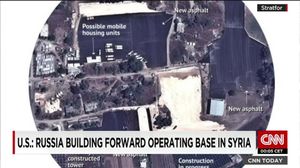
Baghdad recently announced that it wants a bigger role for Russia than the US in Iraq. That’s a real slap in the face after ten years of ‘freedom and democracy delivered free of charge’. Afghanistan too has recently been making overtures to the Russians for military help against the Taliban. Coincidentally (or not!), U.S. Defense Secretary Ash Carter announced yesterday that NATO’s ‘mission’ in Afghanistan may have to be extended 5 years beyond the planned 2016 removal of NATO troops. Not to be outdone, a top Russian diplomat announced (also yesterday) that ‘ISIL’ is not only training Russian-born jihadis in Afghanistan, but that they are being trained by US and UK nationals! Cue Russian bombing of ‘ISIL’ in Afghanistan?
It’s vitally important for as many people as possible to see ‘behind the curtain’ of the geopolitical shenanigans that are currently dominating the headlines. We read stories in the Western press that Cameron, Obama or whoever will not support Russian airstrikes against ISIL in Syria until Russia stops supporting Assad, because Assad is such a “bloodthirsty dictator”. This is such fantastically and self-evidently childish nonsense that it’s embarrassing to watch these political talking-heads try their best to sound like they really, really mean it.
If Assad is such a ‘bad man’, why was he feted at Buckingham Palace more than 2 years into his first term? If Gaddafi was such a ‘cruel dictator’, why was he invited to set up tent and then dine at the Elysee Palace in December 2007? The world of realpolitik is deliberately hidden from public view because Western politicians fear that if their real words and deeds were ever exposed, “the people will chase us down the streets and lynch us” as George H W Bush once warned.
The last 100 years of world history has been dominated and shaped by oil and, more recently, gas wars, primarily between the major powers. It’s not an exaggeration to say that millions of innocent people have been slaughtered, mostly by Western governments and their militaries, to secure access to – and control over – oil and gas, and to ensure that everyone else is kept in a relatively impoverished, subservient position. This is an important point; the world contains more than enough natural resources so that all countries could prosper, but the pathology of the empire-builders in the West demands that they, and only they, control the world at the expense of others.
Life, the universe, or whatever you want to call it, has an uncanny ability to ‘speak’ to us if we are attentive enough to read the ‘signs’. An analogy often used to describe this universal messaging service is that of a billboard, where at first the message appears on the billboard in small, innocuous text. When the message is ignored, the text grows bigger, if it is still ignored, flashing lights are added. Finally, the billboard falls on our head. I find it interesting that as the world continues its inexorable descent into wars and crises over oil and gas, the incidence of anomalous oil and gas explosions, many of which appear to be natural in origin, is increasing at an alarming rate. Is the ‘universe’ trying to tell us something?
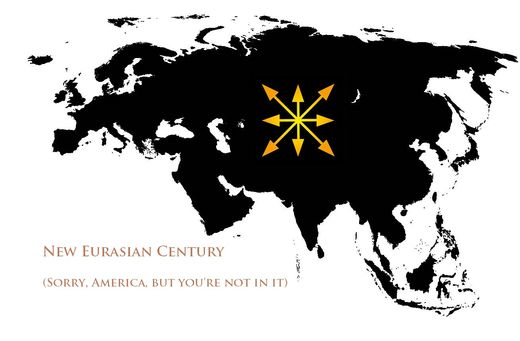
Great post Joe.
Happy that you found it useful Jamie.
this is an amazing piece, thank you for putting this together.
Glad you found it useful Tim
Thank you
Brilliant synthesis of the stakes and strategies of the Empire. Follow the money (petro dollars) and the big picture appears like words written on the wall.
You might want to add the GMO ploy. It is the Joker of the money war. Oil will end sometime in the future. Dollars will then need to be backed up by another commodity.
Gold was too scarce, it could only last up to 1971. , oil is still abundant but it will eventually end,
What could be better than control over an endlessly renewable commodity:
food (coming from solar energy and patented on top of it) This may explain the power of Monsanto, Syngenta and other companies who impose their frankenfood.
Now you have the winning gambit.
wow that was great historical post learnt a lot from that
Extremely pleasant and amazing article you have posted. Its extremely accommodating, i have perused and bookmark this site and will prescribe it to more different people groups.